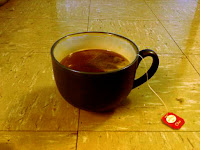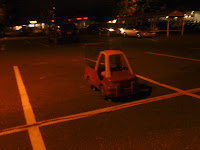This first piece is an attempt at photo-realism. I created the base for the donuts using a torus. Then, I ran a fluid simulation to make the chocolate topping fall onto the donut in a realistic way. The sprinkles started out as a particle system added to the chocolate topping. The particles appeared in random places on the top of the donut, and then I replaced each particle with a sprinkle. The floor is a seamless image of a wood floor with some geometric displacement for the reflections to seem more realistic. Finally, I duplicated the donut twice, colored one pink, and started with the compositing.
The compositing phase of the project was quite simple. I added a focal point on the closest donut by adding a blur on the objects that are further away from the camera. I also blurred the floor closer to the camera to create a nicer depth of field. After that, I did a small amount of color correction, and finished with a somewhat realistic image.
This next piece is my most recent work. It was created as an attempt at photo-realism in nature. Most of my images are geometric, but I decided to change that with an attempt to recreate the Windows XP default background field.
I started with a plane with small hills added to it. I added a particle system with 8000 individual particles. Each particle had 100 child particles, which puts the amount of grass stands at 800,000. Each blade of grass was colored so that the color changes from dark green to yellow-green going up the strand. The background is just a picture of sky, and the sun is just a circle with a glare added to it.
Because of the color correction section of the course, I decided to use some of the techniques learned in class to make the image better. I added a Curves modifier to edit the RGB curve. I gave it an "S" shape, which actually made the image seem more realistic than before. After the ridiculous rendering time, the image was finally done.
This image is one of the drawings I did for the idea/environment/portrait project. This portrays the idea of complexity and chaos. I started with a sphere as the base of the model. I selected random faces on the square, then extruded those into a maze-like shape. The inner sphere is essentially a light that doesn't emit onto the maze shape.
After the modelling was over, I added a glare to the inner light, and gave the center of the image a foggy glow to make the center of the sphere similar to a black hole. I altered the curves on this image as well to add contrast.
This skull is based loosely on the cover art for the Boyz Noize album "Oioioi" seen here. I created the basic model of a human skull, then replaced it with tiny cubes. Then, I gave the skull and the ground a reflective material.
This next piece is almost a test to see how light reflects and refracts within a transparent material. I created the model using simple techniques, then duplicated it. One copy is bigger than the other. The inner shape is completely black, while the outer shape is made of glass.
The edges of the shape interact with the frame in strange ways. The center of the shape has two edges facing towards the top two corners, and the bottom edge cuts the frame in half. This causes the eye to flow through the image naturally.
The lighting was something that was inspired by Martin Schoeller's pictures of celebrities. He has one bright fluorescent light behind the camera. This is what I recreated in 3-D. I also went into Photoshop to enhance the contrast using the curves editor. This exaggerated the effect, and made the shape cooler to look at.


































